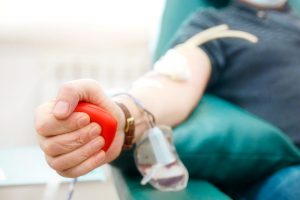 Approximately every two seconds, someone in the United States needs a transfusion of blood, platelets, or plasma. However, this critically-needed blood is often in short supply, as only about 3% of eligible people donate blood each year.
Approximately every two seconds, someone in the United States needs a transfusion of blood, platelets, or plasma. However, this critically-needed blood is often in short supply, as only about 3% of eligible people donate blood each year.
A steady supply of donated blood is necessary for transfusions during a wide range of surgical procedures to counteract any blood loss that may occur. Approximately 21 million blood components are transfused throughout the U.S. each year.
Blood donations are also crucial for treating severe injuries. Victims of car accidents who have incurred severe injuries and blood loss can sometimes require as many as 100 units of blood; a healthy human body, in comparison, typically only holds about 10 units of blood at any given time. Additionally, transfusions are an essential part of treatment for chronic conditions that cause anemia, such as cancer or kidney disease.
There are four common types of donations: whole blood donations, red blood cell donations, plasma donations, and platelet donations.
Whole blood donations: This type of donation contributes approximately one pint of blood and includes all contents of the blood, including red blood cells, platelets, and plasma.
Red blood cell donations: People who meet certain height and weight requirements may be able to donate only their red blood cells; your platelets and plasma are returned to your bloodstream.
Plasma donations: A plasma donation only contributes your plasma, which is most often needed to treat accident and burn victims. Plasma transports protein and nutrients throughout the body.
Platelet donations: Platelets enable blood clotting, which prevents blood loss after sustaining an injury. This type of donation is needed for various types of patients, including accident victims, cancer patients, and people with blood clotting problems.
To make a donation, you can schedule an appointment at a blood drive or donor center near your area through the New York Blood Center.
All content of this newsletter is intended for general information purposes only and is not intended or implied to be a substitute for professional medical advice, diagnosis or treatment. Please consult a medical professional before adopting any of the suggestions on this page. You must never disregard professional medical advice or delay seeking medical treatment based upon any content of this newsletter. PROMPTLY CONSULT YOUR PHYSICIAN OR CALL 911 IF YOU BELIEVE YOU HAVE A MEDICAL EMERGENCY.
